Results
-
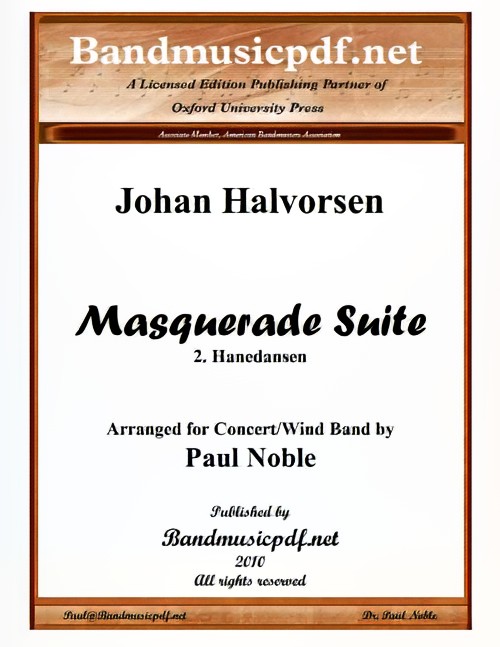 £75.00
£75.00Hanedansen (from Masquerade Suite) (Concert Band - Score and Parts) - Halvorsen, Johan - Noble, Paul
Masquerade Suite was composed by Johan Halvorsen, one of the best-kept secrets of Norway. Not only was he an accomplished violinist and conductor, but also he was among the most prominent Norwegian composers in the generation following Edvard Grieg. His compositions develop the national Romantic tradition of his friends Grieg and Svendsen, but his was a distinctive style marked by brilliant orchestration inspired by the French Romantic composers. The original version of Masquerade Suite had nine movements. Paul Noble has selected five of the most suitable movements for band transcription and grouped them into this beautiful suite. The U.S. Navy Band in Washington, D.C. gave the premiere performance of this work. The first movement, Holberg Overture, sets the mood, pace, and musical themes for the entire suite, with rousing opening themes, followed by a grand fugue in the development section. This is clearly a piece for accomplished bands, giving all wind players a real workout. Each of the succeeding movements has a distinctive style, making the suite a significant addition to the repertoire of the Concert Band. Especially noteworthy is the Arietta, the easiest of the movements, and can easily stand alone with its haunting flute and oboe melodies and dramatic crescendo, the crisp solos in the Molinasque, and the final movement, which is very much like a circus march, fast, lively and short!
Estimated dispatch 7-14 working days
-
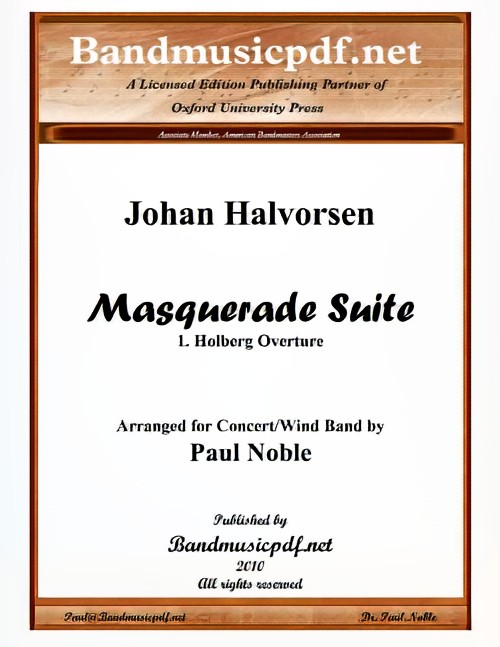 £75.00
£75.00Holberg Overture (from Masquerade Suite) (Concert Band - Score and Parts) - Halvorsen, Johan - Noble, Paul
Masquerade Suite was composed by Johan Halvorsen, one of the best-kept secrets of Norway. Not only was he an accomplished violinist and conductor, but also he was among the most prominent Norwegian composers in the generation following Edvard Grieg. His compositions develop the national Romantic tradition of his friends Grieg and Svendsen, but his was a distinctive style marked by brilliant orchestration inspired by the French Romantic composers. The original version of Masquerade Suite had nine movements. Paul Noble has selected five of the most suitable movements for band transcription and grouped them into this beautiful suite. The U.S. Navy Band in Washington, D.C. gave the premiere performance of this work. The first movement, Holberg Overture, sets the mood, pace, and musical themes for the entire suite, with rousing opening themes, followed by a grand fugue in the development section. This is clearly a piece for accomplished bands, giving all wind players a real workout. Each of the succeeding movements has a distinctive style, making the suite a significant addition to the repertoire of the Concert Band. Especially noteworthy is the Arietta, the easiest of the movements, and can easily stand alone with its haunting flute and oboe melodies and dramatic crescendo, the crisp solos in the Molinasque, and the final movement, which is very much like a circus march, fast, lively and short!
Estimated dispatch 7-14 working days
-
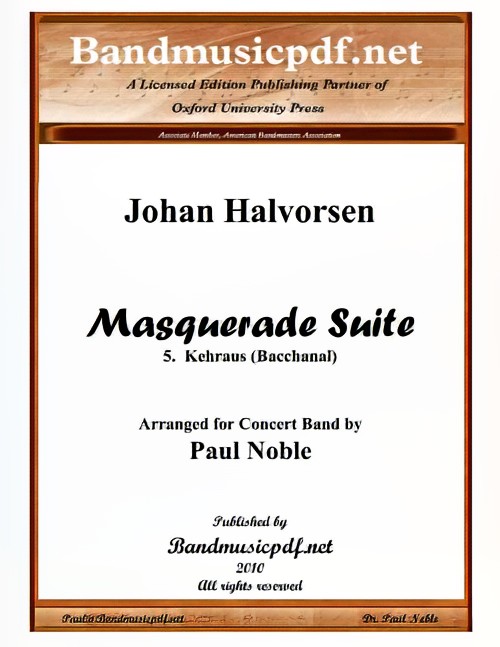 £65.00
£65.00Kehraus (from Masquerade Suite) (Concert Band - Score and Parts) - Halvorsen, Johan - Noble, Paul
Masquerade Suite was composed by Johan Halvorsen, one of the best-kept secrets of Norway. Not only was he an accomplished violinist and conductor, but also he was among the most prominent Norwegian composers in the generation following Edvard Grieg. His compositions develop the national Romantic tradition of his friends Grieg and Svendsen, but his was a distinctive style marked by brilliant orchestration inspired by the French Romantic composers. The original version of Masquerade Suite had nine movements. Paul Noble has selected five of the most suitable movements for band transcription and grouped them into this beautiful suite. The U.S. Navy Band in Washington, D.C. gave the premiere performance of this work. The first movement, Holberg Overture, sets the mood, pace, and musical themes for the entire suite, with rousing opening themes, followed by a grand fugue in the development section. This is clearly a piece for accomplished bands, giving all wind players a real workout. Each of the succeeding movements has a distinctive style, making the suite a significant addition to the repertoire of the Concert Band. Especially noteworthy is the Arietta, the easiest of the movements, and can easily stand alone with its haunting flute and oboe melodies and dramatic crescendo, the crisp solos in the Molinasque, and the final movement, which is very much like a circus march, fast, lively and short!
Estimated dispatch 7-14 working days
-
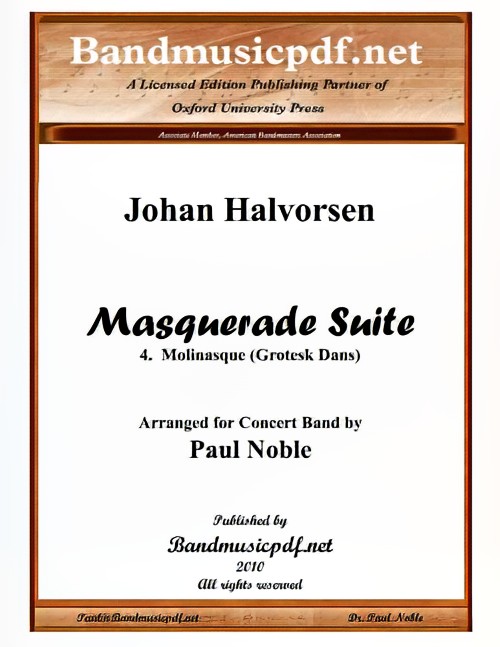 £75.00
£75.00Molinasque (from Masquerade Suite) (Concert Band - Score and Parts) - Halvorsen, Johan - Noble, Paul
Masquerade Suite was composed by Johan Halvorsen, one of the best-kept secrets of Norway. Not only was he an accomplished violinist and conductor, but also he was among the most prominent Norwegian composers in the generation following Edvard Grieg. His compositions develop the national Romantic tradition of his friends Grieg and Svendsen, but his was a distinctive style marked by brilliant orchestration inspired by the French Romantic composers. The original version of Masquerade Suite had nine movements. Paul Noble has selected five of the most suitable movements for band transcription and grouped them into this beautiful suite. The U.S. Navy Band in Washington, D.C. gave the premiere performance of this work. The first movement, Holberg Overture, sets the mood, pace, and musical themes for the entire suite, with rousing opening themes, followed by a grand fugue in the development section. This is clearly a piece for accomplished bands, giving all wind players a real workout. Each of the succeeding movements has a distinctive style, making the suite a significant addition to the repertoire of the Concert Band. Especially noteworthy is the Arietta, the easiest of the movements, and can easily stand alone with its haunting flute and oboe melodies and dramatic crescendo, the crisp solos in the Molinasque, and the final movement, which is very much like a circus march, fast, lively and short!
Estimated dispatch 7-14 working days
-
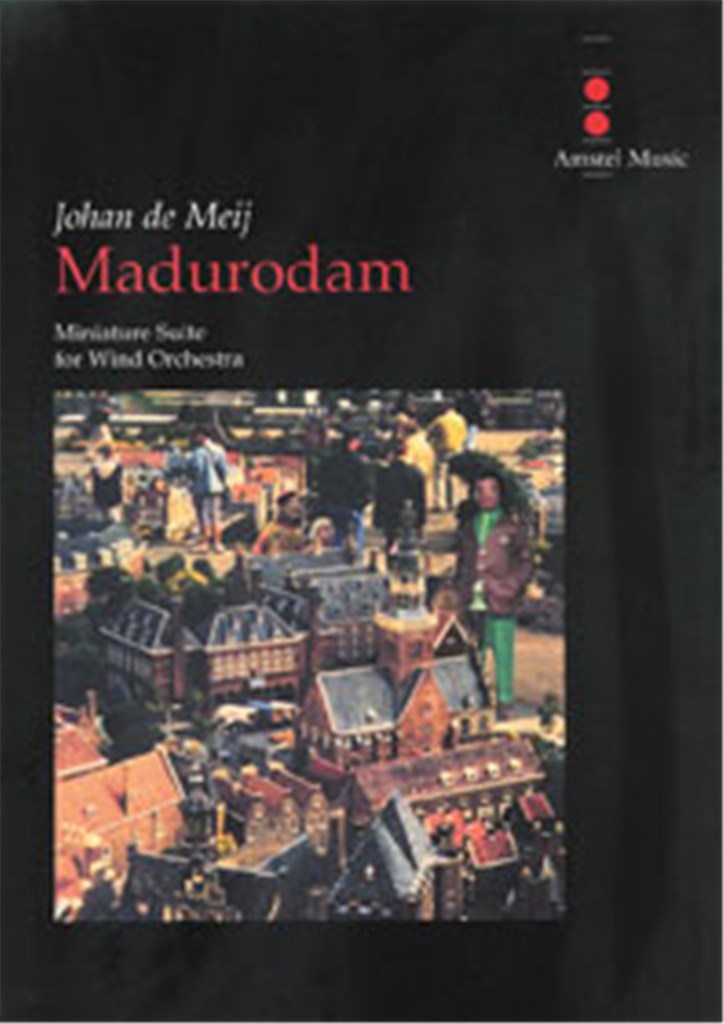 £132.00
£132.00Madurodam (Concert Band - Score and Parts) - De Meij, Johan
Madurodam is a small scale miniature town at Scheveningen (near The Hague) and is since many years one of the most important tourist attractions of the conurbation of Western Holland (called Randstad). On a scale 1:25 a charming picture of The Netherlands is given in bird's eye view: several important buildings, churches and townscapes are reconstructed up to the smallest details. There is also a fine transport system: a network of railroads, harbours and motorways covers the park and Madurodam Airport enables air traffic with all continents. The miniature suite Madurodam consists of eight short parts presenting a musical impression of the smallest town in The Netherlands.Reveille the piccolo flute and the side drum announce a new dayToy Soldiers there is a military parade in front of the George Maduro BarracksBinnenhof/Buitenhof a solemn melody is the main theme of the suite and depicts the state buildings and the nearby lake Hofvijver at The HagueSmall Windmills everything that moves or whirls at Madurodam is described in this barrel organ waltzIntermezzo/Nocturne Madurodam by night is described by a solemn passage played in unison by the lower instrumentsThe Westerkerk Church also the capital Amsterdam is represented with the chimes of the famous Westerkerk churchThe Muiderslot Castle an elegant pavane recalls medieval atmospheresGrande Finale the windmill theme comes back and then the suite comes to an end with the Binnenhof theme, decorated by the first strains of the national hymn, Wilhelmus.Duration: 9.15
Estimated dispatch 7-14 working days
-
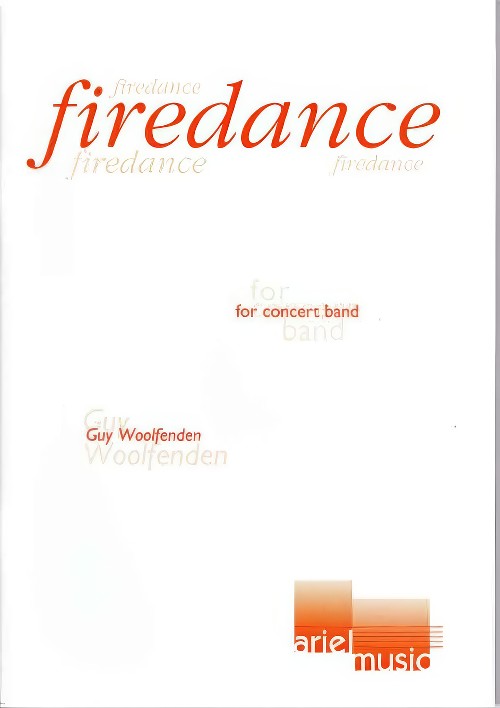 £140.00
£140.00FIREDANCE (Concert Band) - Woolfenden, Guy
Firedance was commissioned by Warwick Castle for one of its celebrated annual fireworks concerts at the Warwick and Leamington Festival. The first performance was given by the Philharmonia Orchestra conducted by Martyn Brabbins on July 1st 2000.Keith Allen, musical director of Birmingham Symphonic Winds, heard the piece at Warwick Castle, and commissioned a new arrangement for BSW's 10th anniversary concert on 16th November 2002 at the CBSO Centre, Birmingham, when it was conducted by the composer.Firedance starts with jagged rhythms in a minor tonality, and apart from a final accelerando, keeps the same pulse for its near ten-minute span, becoming gradually more celebratory, major-key and melodic.This new version for concert band is dedicated to all members of Birmingham Symphonic Winds with great affection. - GW
Estimated dispatch 7-14 working days
-
 £97.02
£97.02Our First Christmas Concert! (Concert Band - Score and Parts)
Stretch your beginning band budget dollars at Christmastime with this outstanding collection of four holiday favorites! Includes four complete band arrangements in one, all grade 1.5. Includes: A CHRISTMAS CLASSIC by James Swearingen DOWN THROUGH THE CHIMNEY by Jerry Williams THE SEASON by James Swearingen A SNOWY CHRISTMAS DAY by Jerry Williams
Estimated dispatch 7-14 working days
-
 £97.02
£97.02Our First Spring Concert! (Concert Band - Score and Parts)
Got the end of the year empty budget blues? Program your beginning band's spring concert with this great value of four beginning band selections in one bargain-priced package! Includes: PATRIOTS ON PARADE MARCH by Ken Harris AS THE EAGLE FLIES by James Swearingen SONG OF THE TELEGRAPH by David Shaffer TACO TIME by Ed Huckeby
Estimated dispatch 7-14 working days
-
 £199.99
£199.99Suite Pastorale - Franco Cesarini
Suite Pastorale, made up of three movements - Idyll, Playful Shepherd Boys, Rain Upon the Fields - is characterized by an idealization of the simplicity of country life in close contact with nature. Suite Pastorale depicts the eternal and fascinating myth of Arcadia: a world in which man lives in harmony with nature, immersed in bucolic forest landscapes, one of the most important imaginary places to escape to for those who were, and still are, tired of culture and civilization. The evocative Arcadian world is made almost mythological by the attention dedicated to it by poets, writers, playwrights, painters, and composers who over the centuries have drawn lifeblood from it for their works. Full of metaphorical meanings, it is a place of shelter, a place to live and sing about love, even if it means disappointment, and it is the place of civilization opposed to barbarism. It is a symbol of happiness, a real and intact image of reality, motionless in space and time, where nothing changes. The myth of the "locus amoenus" has not disappeared but has kept all its charm intact over the centuries.Suite Pastorale was commissioned to Franco Cesarini by the concert band of Aldeno (Trento/Italy) for the 100th anniversary of its foundation (1923-2023.Suite Pastorale: an ideal concert piece that will delight your audience!
Estimated dispatch 7-14 working days
-
 £118.99
£118.99Cats - Andrew Lloyd Webber
The Musical CATS, with music by Andrew Lloyd Webber is based on the 1939 poetry collection Old Possum's Book of Practical Cats by T. S. Eliot. It became Lloyd Webber's third great success, after the musicals Jesus Christ Superstar and Evita. He began setting Eliot's poems to music in 1977, and the compositions were first presented as a song cycle in 1980. Producer Cameron Mackintosh then recruited director Trevor Nunn and choreographer Gillian Lynne to turn the songs into a complete musical. CATS became one of the longest-running shows in West End and Broadway history. It received its world premiere at the New London Theatre in 1981, where it played for 21 record-breaking years and almost 9,000 performances. The following year, CATS opened at New York's Winter Garden Theatre, its home for the next 18 years, garnering seven 1983 Tony Awards, including Best Musical. The show returned to Broadway in 2016, where it had a successful pre-tour run at the Neil Simon Theatre. CATS has been presented in over 30 countries, translated into 16 languages, and seen by more than 73 million people worldwide. Lloyd Webber's magnificent musical score includes the poignant hit song Memory, which has been recorded by over 150 artists, from Barbra Streisand to Liberace to Barry Manilow. It took 7,486 chandelier crashes for Lloyd Webber's The Phantom of the Opera to take over from CATS as the longest-running show in Broadway history in January 2006.
Estimated dispatch 7-14 working days
